Single-Vessel Plume Dispersion Simulation: Method and a Case Study Using CALPUFF in the Yantian Port Area, Shenzhen (China)
Abstract
1. Introduction
2. Methods and Data Source
2.1. Study Area and Object
2.2. Single-Vessel Diffusion Model
2.2.1. Meteorological Model
2.2.2. Automatic Identification System (AIS)-Based Vessel Emissions Inventories
2.2.3. Single Vessel Atmospheric Pollution Diffusion Model Based on CALPUFF
2.2.4. Correction of Plume Lifting Height Calculation
2.2.5. The Statistical Evaluation for the WRF and CALMET
2.3. Data Source
3. Case Studies and Results
3.1. The Statistical Evaluation for the WRF and CALMET Models
3.1.1. The Statistical Evaluation for the WRF
3.1.2. The Statistical Evaluation for the CALMET
3.2. Simulation of Single Ship Exhaust Pollutant Diffusion
3.2.1. Comparison of Simulation Results with Shore-Based Monitoring Data
3.2.2. Impact on the Atmospheric Environment
4. Discussion
5. Conclusions
Author Contributions
Funding
Conflicts of Interest
Appendix A

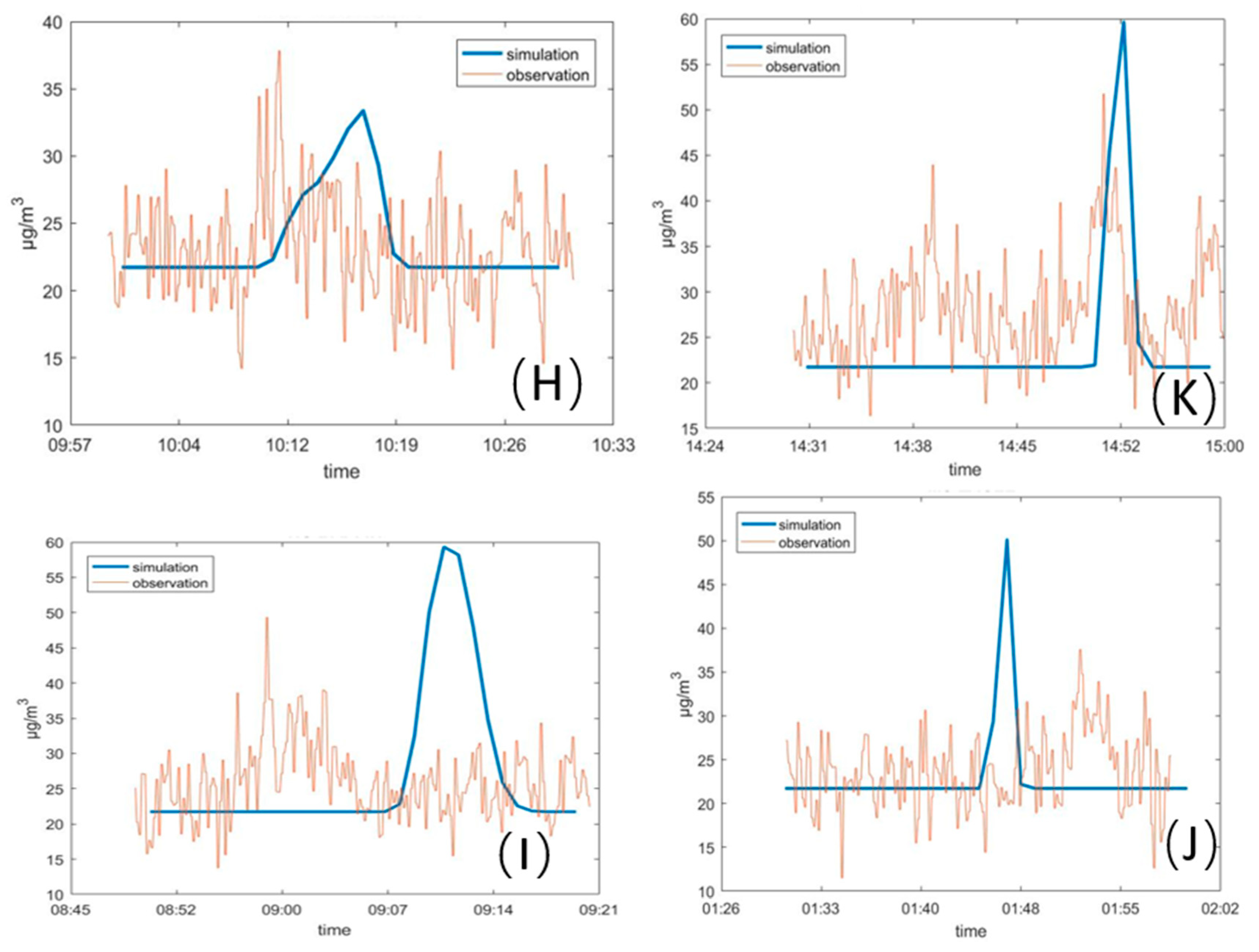
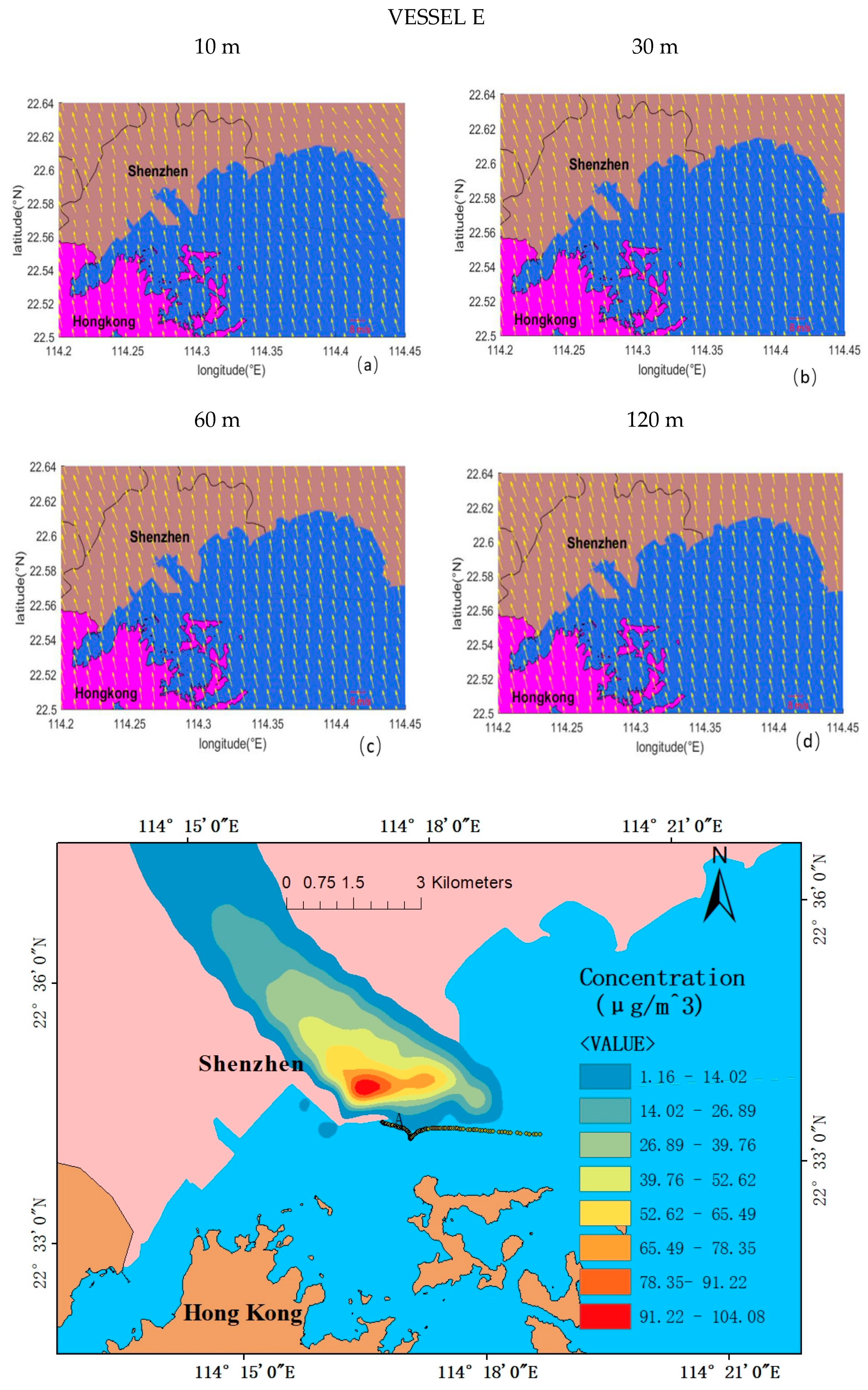
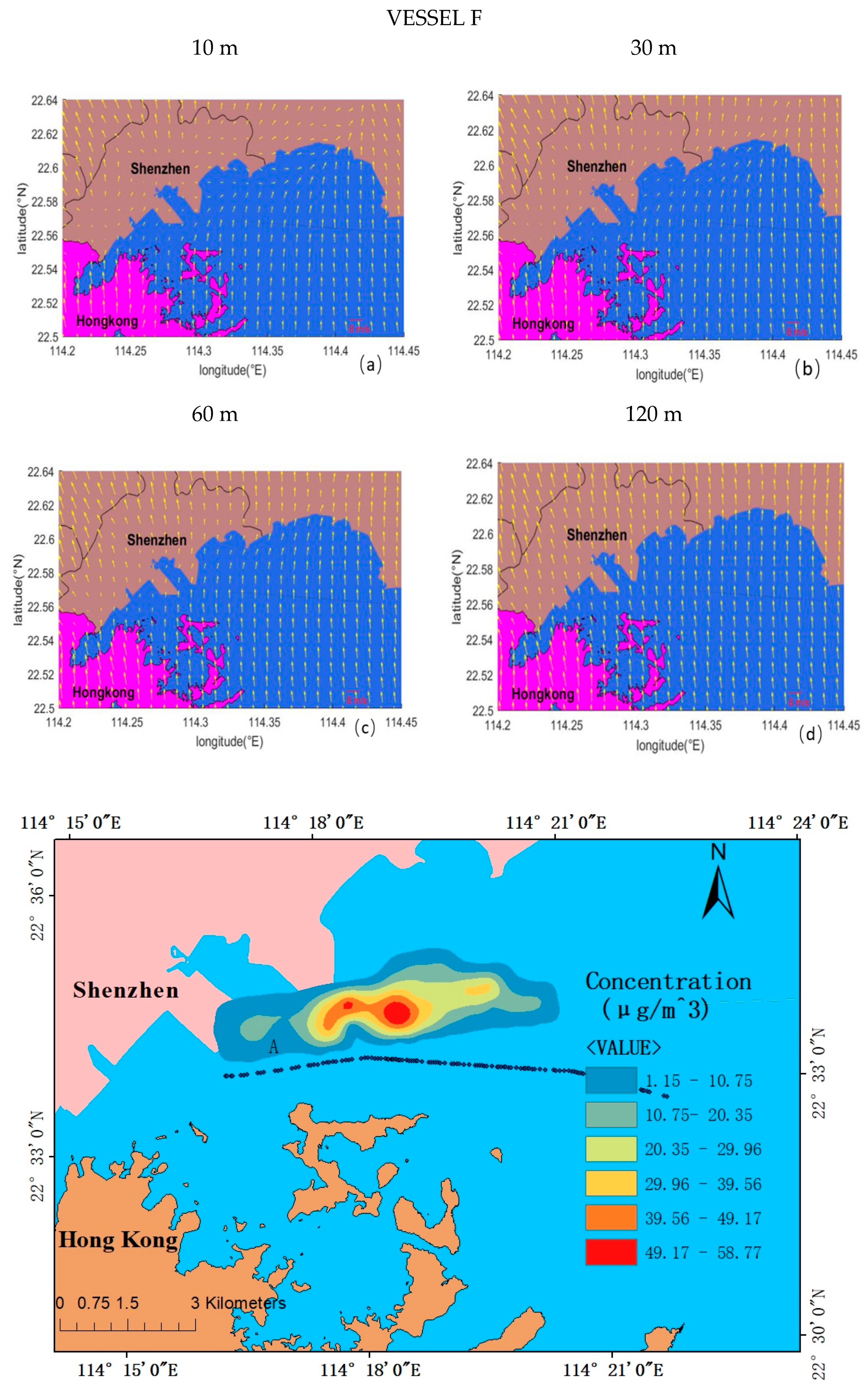
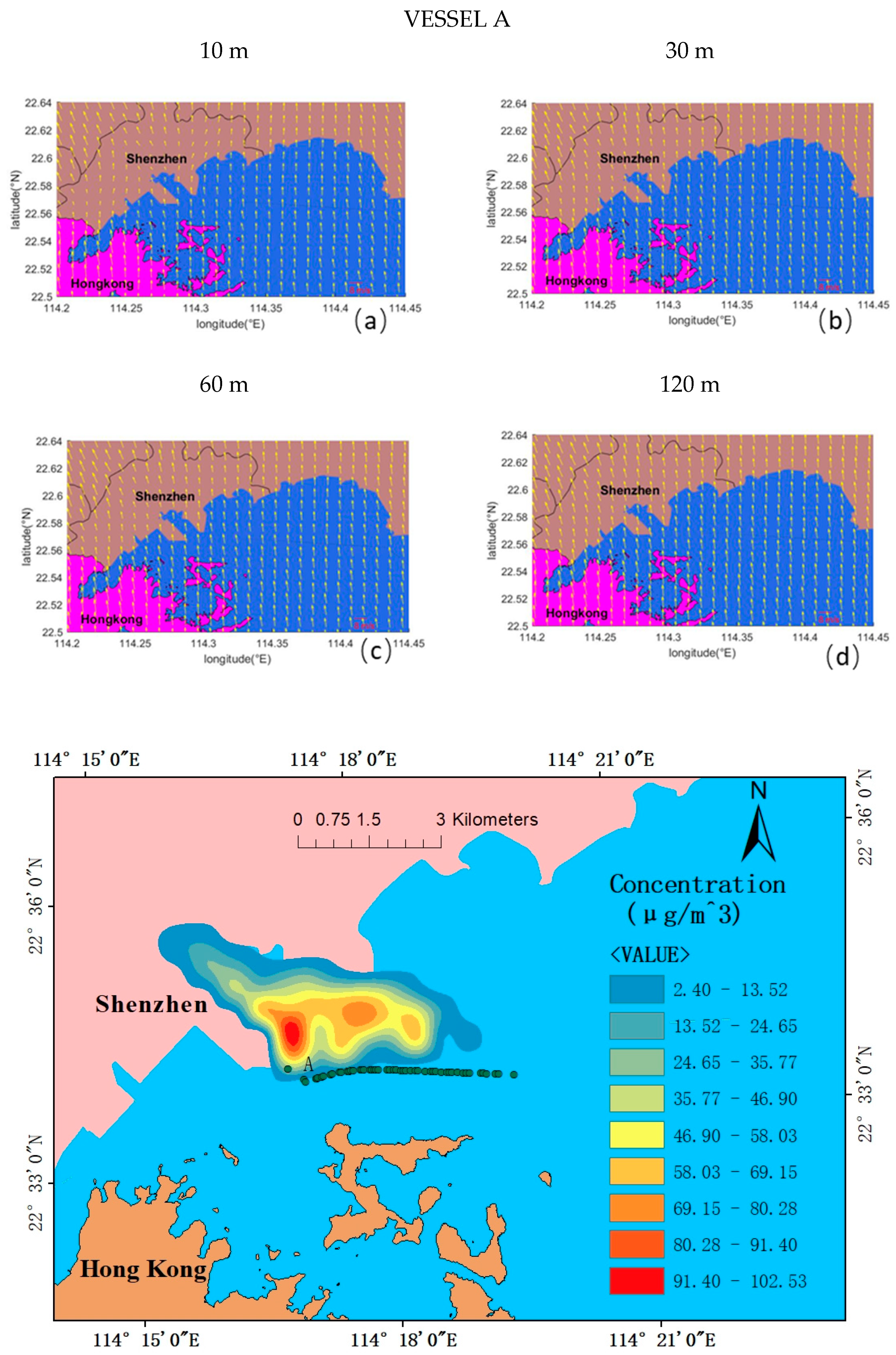
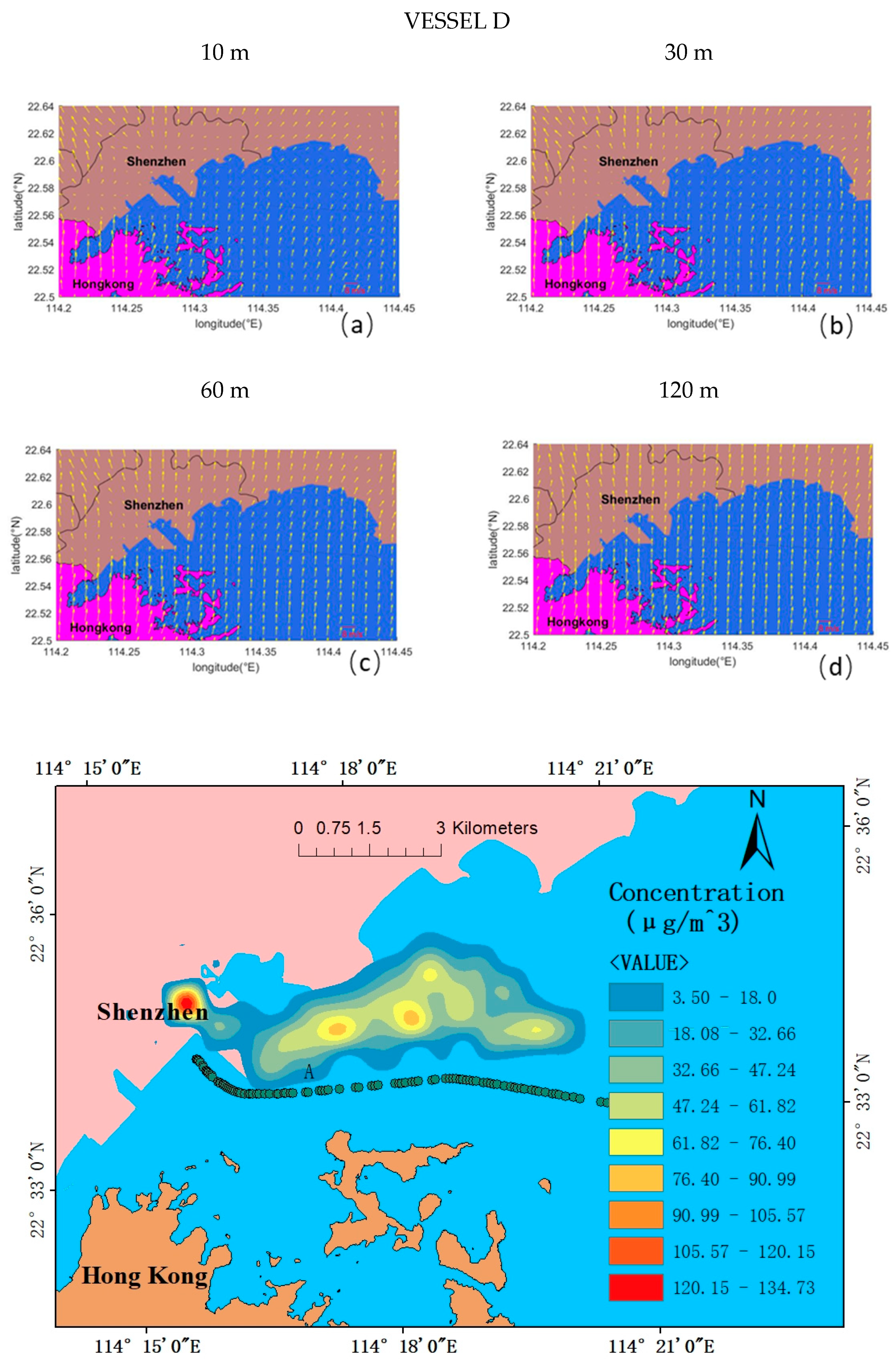
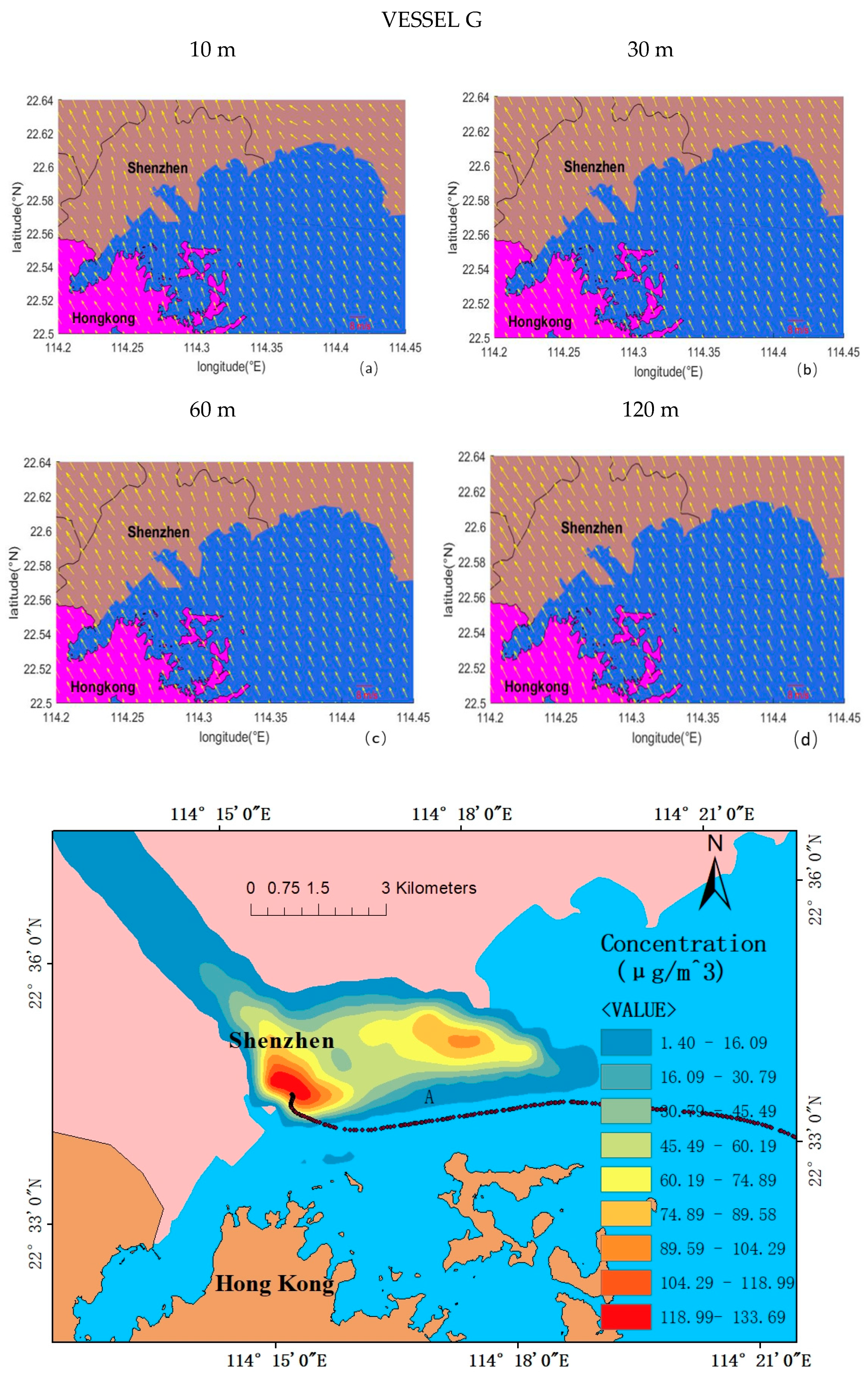
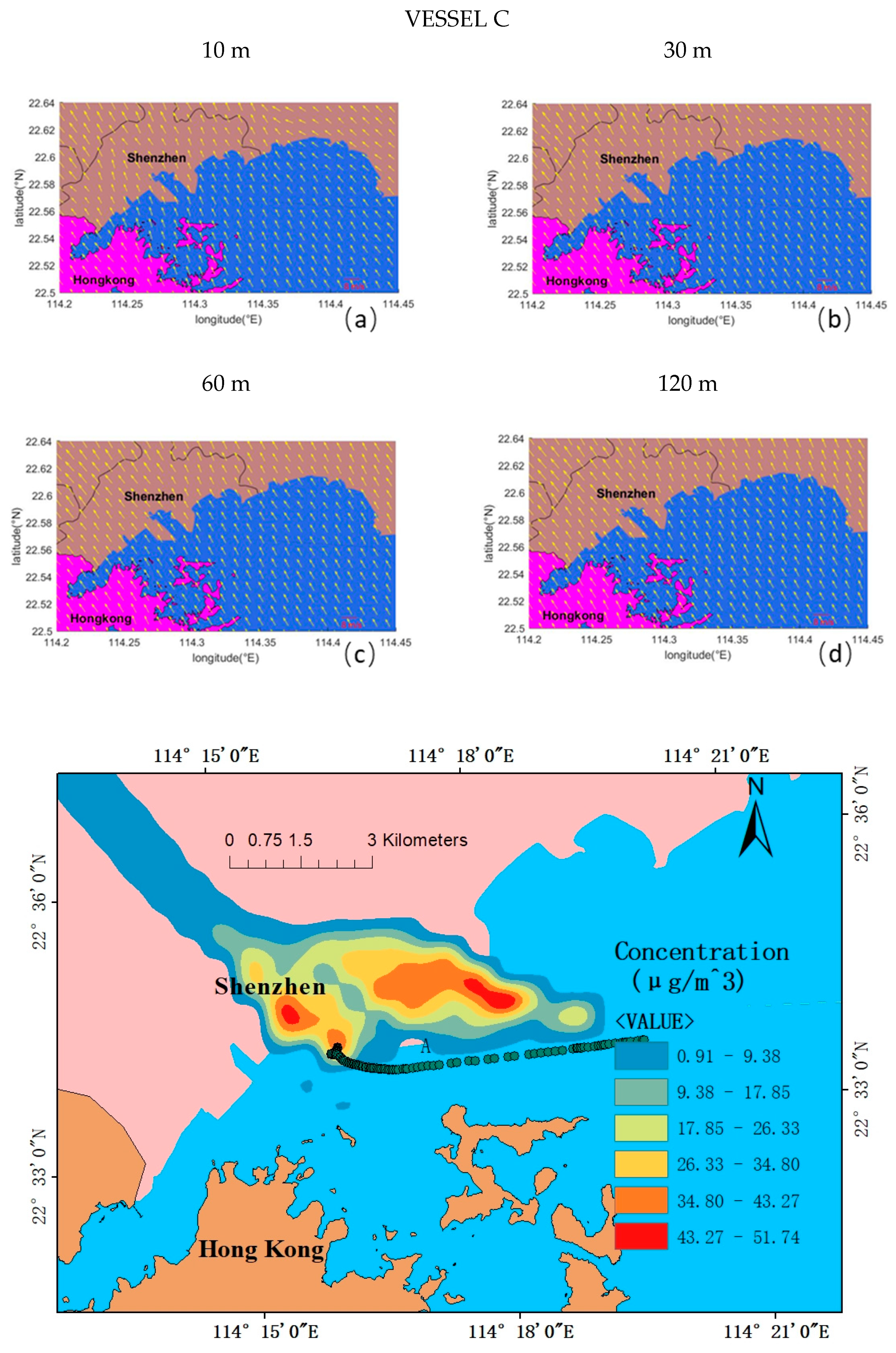

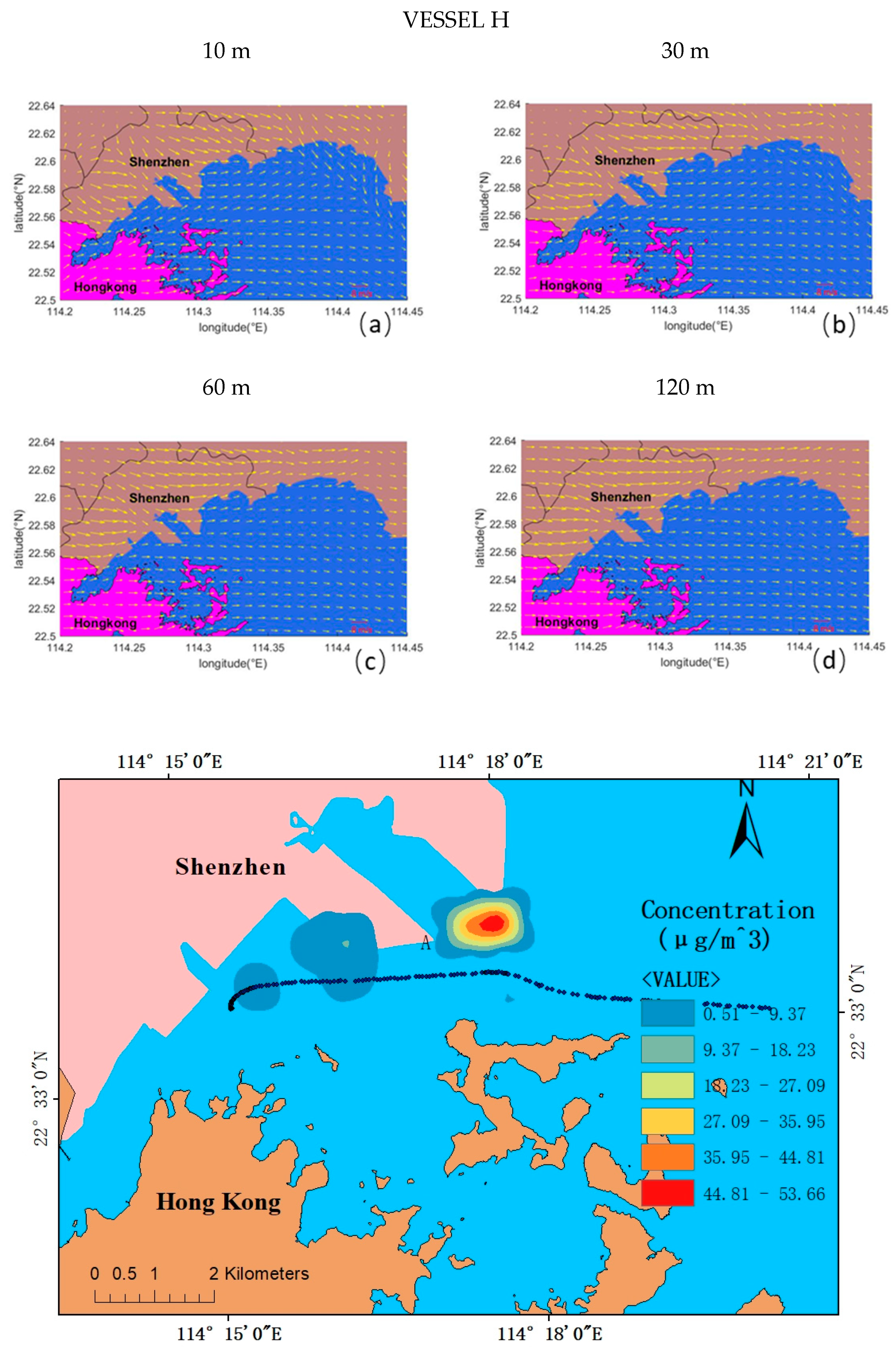
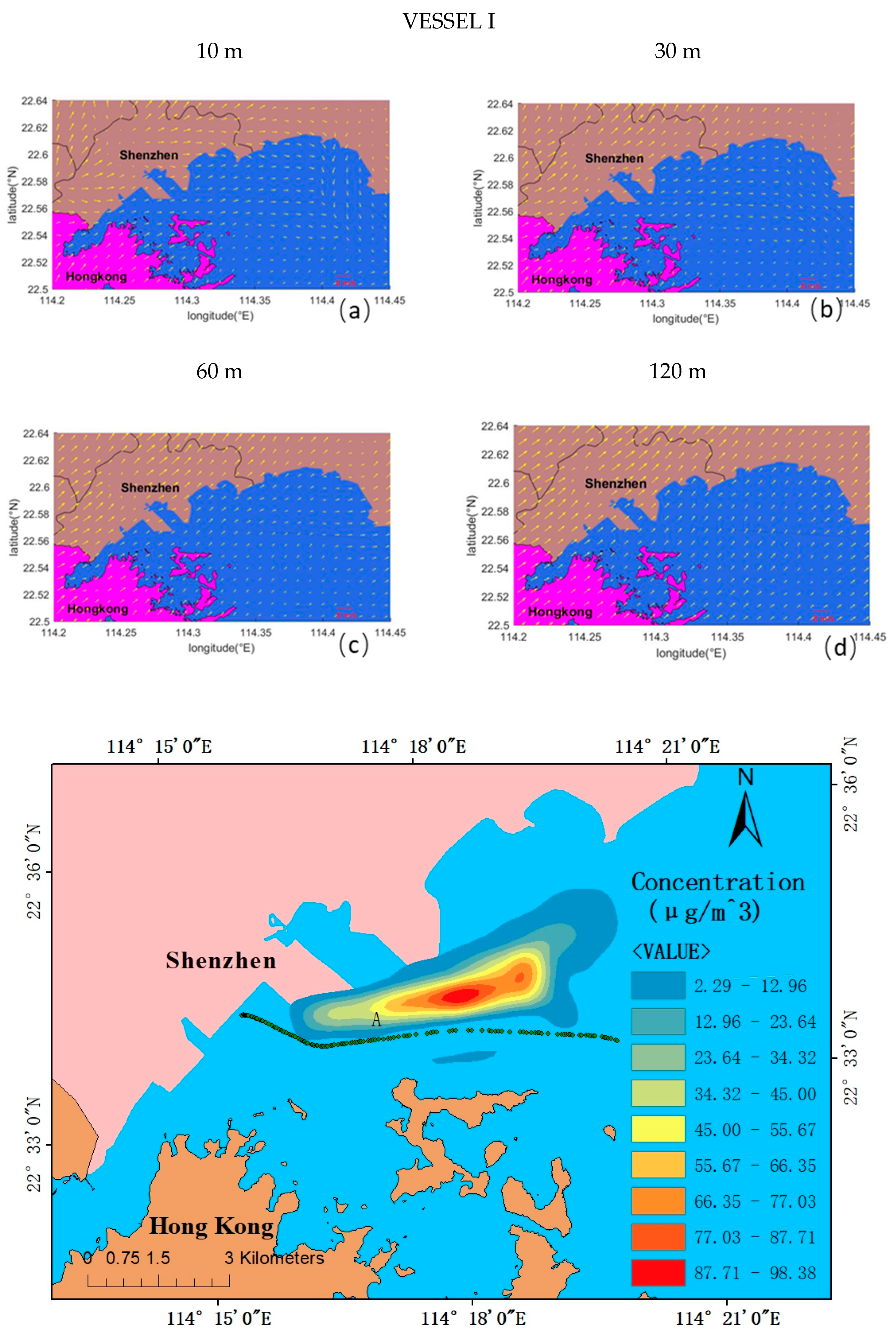
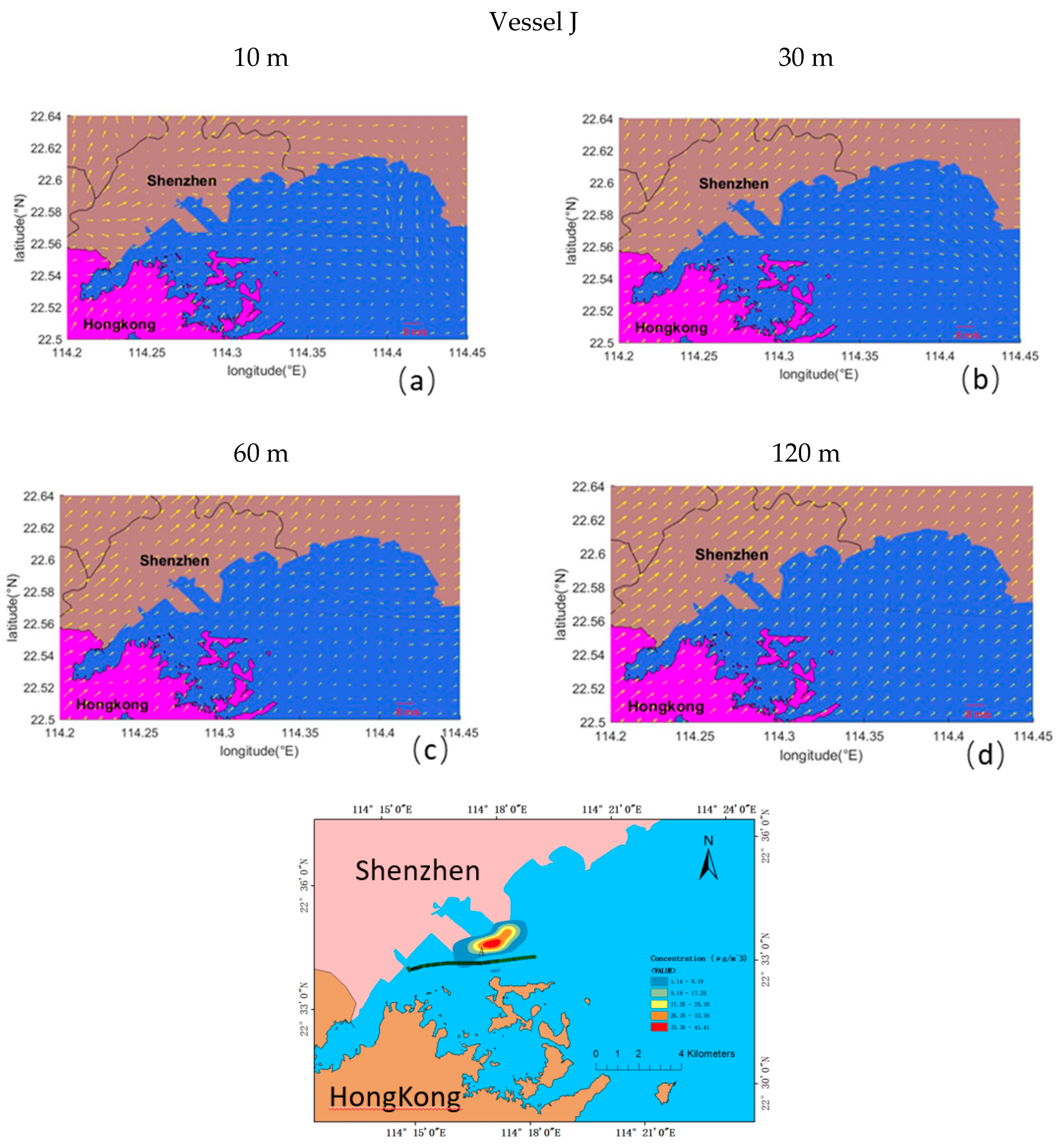
References
- Streets, D.G.; Guttikunda, S.K.; Carmichael, G.R. The growing contribution of sulfur emissions from ships in Asian waters, 1988–1995. Atmos. Environ. 2000, 34, 4425–4439. [Google Scholar] [CrossRef]
- Cohan, A.; Wu, J.; Dabdub, D. High-resolution pollutant transport in the San Pedro Bay of California. Atmos. Pollut. Res. 2011, 2, 237–246. [Google Scholar] [CrossRef]
- Davies, M. Ship emissions from Australian ports. WIT Trans. Ecol Environ. 2014, 183, 327–337. [Google Scholar]
- Lu, G.; Brook, J.R.; Alfarra, M.R.; Anlauf, K.; Leaitch, W.R.; Sharma, S.; Wang, D.; Worsnop, D.R.; Phinney, L. Identification and characterization of inland ship plumes over Vancouver, BC. Atmos. Environ. 2006, 40, 2767–2782. [Google Scholar] [CrossRef]
- Dalsoren, S.B.; Eide, M.S.; Endresen, O.; Mjelde, A.; Gravir, G.; Isaksen, I.S.A. Update on emissions and environmental impacts from the international fleet of ships: The contribution from major ship types and ports. Atmos. Chem. Phys. 2009, 9, 2171–2194. [Google Scholar] [CrossRef]
- Lonati, G.; Cernuschi, S.; Sidi, S. Air quality impact assessment of at-berth ship emissions. Case-study for the project of a new freight port. Sci. Total Environ. 2010, 409, 192–200. [Google Scholar] [CrossRef]
- Capaldo, K.; Corbett, J.J.; Kasibhatla, P.; Fischbeck, P.; Pandis, S.N. Effects of ship emissions on sulphur cycling and radiative climate forcing over the ocean. Nature 1999, 400, 743–746. [Google Scholar] [CrossRef]
- Kattner, L.; Mathieu-Ueffing, B.; Burrows, J.P.; Richter, A.; Schmolke, S.; Seyler, A.; Wittrock, F. Monitoring compliance with sulfur content regulations of shipping fuel by in situ measurements of ship emissions. Atmos. Chem. Phys. 2015, 15, 10087–10092. [Google Scholar] [CrossRef]
- Tien Anh, T. Design the prediction model of low-sulfur-content fuel oil consumption for M/V NORD VENUS 80,000 DWT sailing on emission control areas by artificial neural networks. Proc. Inst. Mech. Eng. Part M J. Eng. Marit. Environ. 2019, 233, 345–362. [Google Scholar]
- Animah, I.; Addy-Lamptey, A.; Korsah, F.; Sackey, J.S. Compliance with MARPOL Annex VI regulation 14 by ships in the Gulf of Guinea sub-region: Issues, challenges and opportunities. Transport. Res. Part D-Transport. Environ. 2018, 62, 441–455. [Google Scholar] [CrossRef]
- Fan, Q.; Zhang, Y.; Ma, W.; Ma, H.; Feng, J.; Yu, Q.; Yang, X.; Ng, S.K.W.; Fu, Q.; Chen, L. Spatial and Seasonal Dynamics of Ship Emissions over the Yangtze River Delta and East China Sea and Their Potential Environmental Influence. Environ. Sci. Technol. 2016, 50, 1322–1329. [Google Scholar] [CrossRef]
- Saxe, H.; Larsen, T. Air pollution from ships in three Danish ports. Atmos. Environ. 2004, 38, 4057–4067. [Google Scholar] [CrossRef]
- Merico, E.; Gambaro, A.; Argiriou, A.; Alebic-Juretic, A.; Barbaro, E.; Cesari, D.; Chasapidis, L.; Dimopoulos, S.; Dinoi, A.; Donateo, A.; et al. Atmospheric impact of ship traffic in four Adriatic-Ionian port-cities: Comparison and harmonization of different approaches. Transport. Res. Part D Transport. Environ. 2017, 50, 431–445. [Google Scholar] [CrossRef]
- Chen, D.; Zhao, N.; Lang, J.; Zhou, Y.; Wang, X.; Li, Y.; Zhao, Y.; Guo, X. Contribution of ship emissions to the concentration of PM2.5: A comprehensive study using AIS data andWRF/Chemmodel in Bohai Rim Region, China. Sci. Total Environ. 2018, 610, 1476–1486. [Google Scholar] [CrossRef]
- Chen, D.; Wang, X.; Nelson, P.; Li, Y.; Zhao, N.; Zhao, Y.; Lang, J.; Zhou, Y.; Guo, X. Ship emission inventory and its impact on the PM2.5 air pollution in Qingdao Port, North China. Atmos. Environ. 2017, 166, 351–361. [Google Scholar] [CrossRef]
- Saracoglu, H.; Deniz, C.; Kilic, A. An Investigation on the Effects of Ship Sourced Emissions in Izmir Port, Turkey. Sci. World J. 2013, 2013, 218324. [Google Scholar] [CrossRef]
- Gariazzo, C.; Papaleo, V.; Pelliccioni, A.; Calori, G.; Radice, P.; Tinarelli, G. Application of a Lagrangian particle model to assess the impact of harbour, industrial and urban activities on air quality in the Taranto area, Italy. Atmos. Environ. 2007, 41, 6432–6444. [Google Scholar] [CrossRef]
- Indumati, S.; Oza, R.B.; Mayya, Y.S.; Puranik, V.D.; Kushwaha, H.S. Dispersion of pollutants over land-water-land interface: Study using CALPUFF model. Atmos. Environ. 2009, 43, 473–478. [Google Scholar] [CrossRef]
- Poplawski, K.; Setton, E.; McEwen, B.; Hrebenyk, D.; Graham, M.; Keller, P. Impact of cruise ship emissions in Victoria, BC, Canada. Atmos. Environ. 2011, 45, 824–833. [Google Scholar] [CrossRef]
- Murena, F.; Mocerino, L.; Quaranta, F.; Toscano, D. Impact on air quality of cruise ship emissions in Naples, Italy. Atmos. Environ. 2018, 187, 70–83. [Google Scholar] [CrossRef]
- Corbett, J.J. New Directions: Designing ship emissions and impacts research to inform both science and policy. Atmos. Environ. 2003, 37, 4719–4721. [Google Scholar] [CrossRef]
- Corbett, J.J.; Koehler, H.W. Updated emissions from ocean shipping. J. Geophys. Res. Atmos. 2003, 108, D20. [Google Scholar] [CrossRef]
- Sinha, P.; Hobbs, P.V.; Yokelson, R.J.; Christian, T.J.; Kirchstetter, T.W.; Bruintjes, R. Emissions of trace gases and particles from two ships in the southern Atlantic Ocean. Atmos. Environ. 2003, 37, 2139–2148. [Google Scholar] [CrossRef]
- Durkee, P.A.; Noone, K.J.; Bluth, R.T. The Monterey Area Ship Track experiment. J. Atmos. Sci. 2000, 57, 2523–2541. [Google Scholar] [CrossRef]
- Jalkanen, J.P.; Brink, A.; Kalli, J.; Pettersson, H.; Kukkonen, J.; Stipa, T. A modelling system for the exhaust emissions of marine traffic and its application in the Baltic Sea area. Atmos. Chem. Phys. 2009, 9, 9209–9223. [Google Scholar] [CrossRef]
- Petzold, A.; Lauer, P.; Fritsche, U.; Hasselbach, J.; Lichtenstern, M.; Schlager, H.; Fleischer, F. Operation of Marine Diesel Engines on Biogenic Fuels: Modification of Emissions and Resulting Climate Effects. Environ. Sci. Technol. 2011, 45, 10394–10400. [Google Scholar] [CrossRef]
- Zhang, Y.; Yang, X.; Brown, R.; Yang, L.; Morawska, L.; Ristovski, Z.; Fu, Q.; Huang, C. Shipping emissions and their impacts on air quality in China. Sci. Total Environ. 2017, 581, 186–198. [Google Scholar] [CrossRef]
- Liu, Z.; Lu, X.; Feng, J.; Fan, Q.; Zhang, Y.; Yang, X. Influence of Ship Emissions on Urban Air Quality: A Comprehensive Study Using Highly Time-Resolved Online Measurements and Numerical Simulation in Shanghai. Environ. Sci. Technol. 2017, 51, 202–211. [Google Scholar] [CrossRef]
- Johansson, L.; Jalkanen, J.P.; Kukkonen, J. Global assessment of shipping emissions in 2015 on a high spatial and temporal resolution. Atmos. Environ. 2017, 167, 403–415. [Google Scholar] [CrossRef]
- US Environmental Protection Agency. Current Methodologies in Preparing Mobile Source Port-Related Emission Inventories; Final Report for US Environmental Protection Agency; US Environmental Protection Agency: Washington, DC, USA, 2009; Volume 96, pp. 19–44.
- Scire, J.S.; Strimaitis, D.G.; Yamartino, R.J. A User’s Guide for the CALPUFF Dispersion Model; Earth Tech Inc.: Long Beach, CA, USA, 2000. [Google Scholar]
- Briggs, G.A. Plume Rise Predictions; American Meteorological Society: Boston, MA, USA, 1982; pp. 59–111. [Google Scholar]


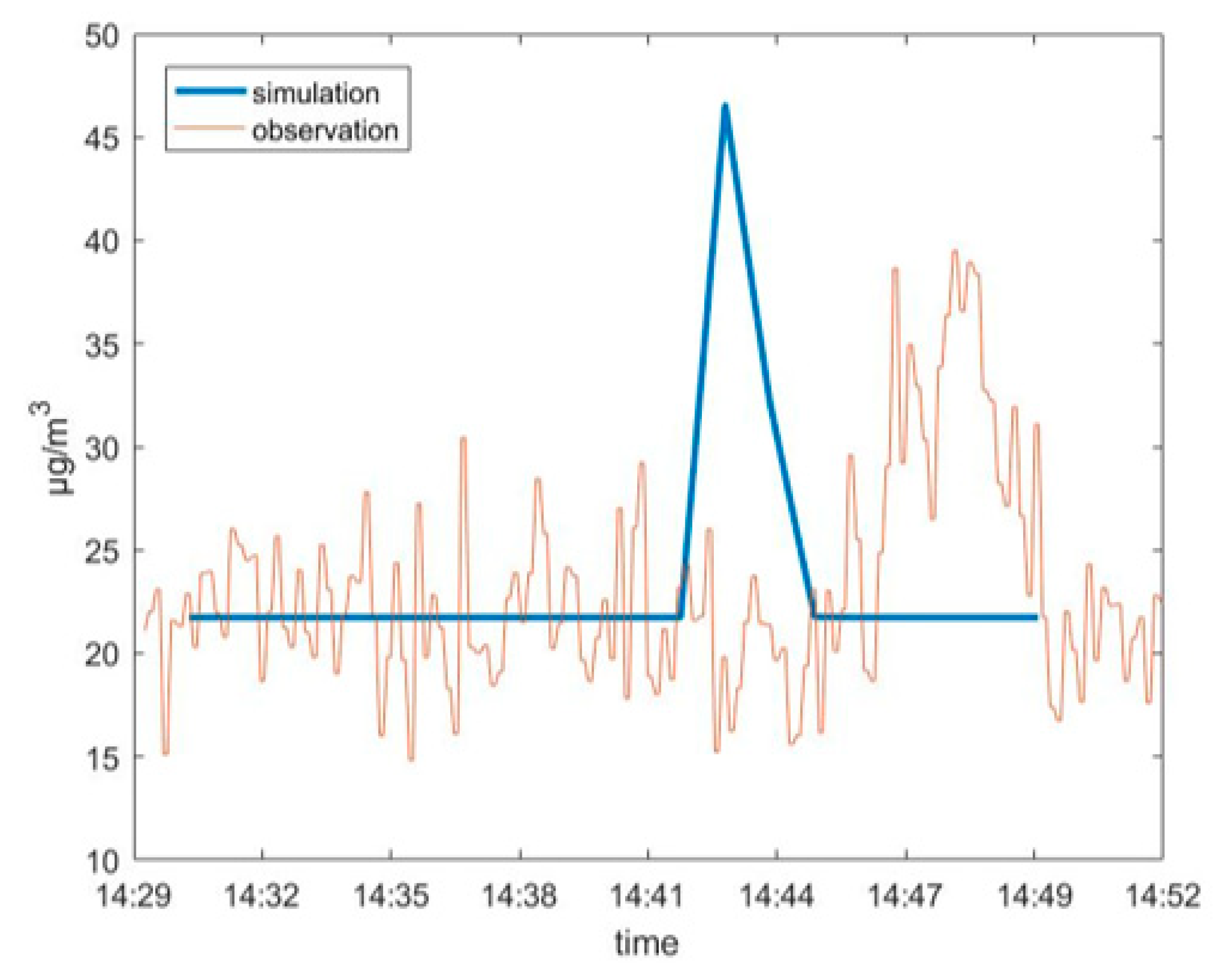
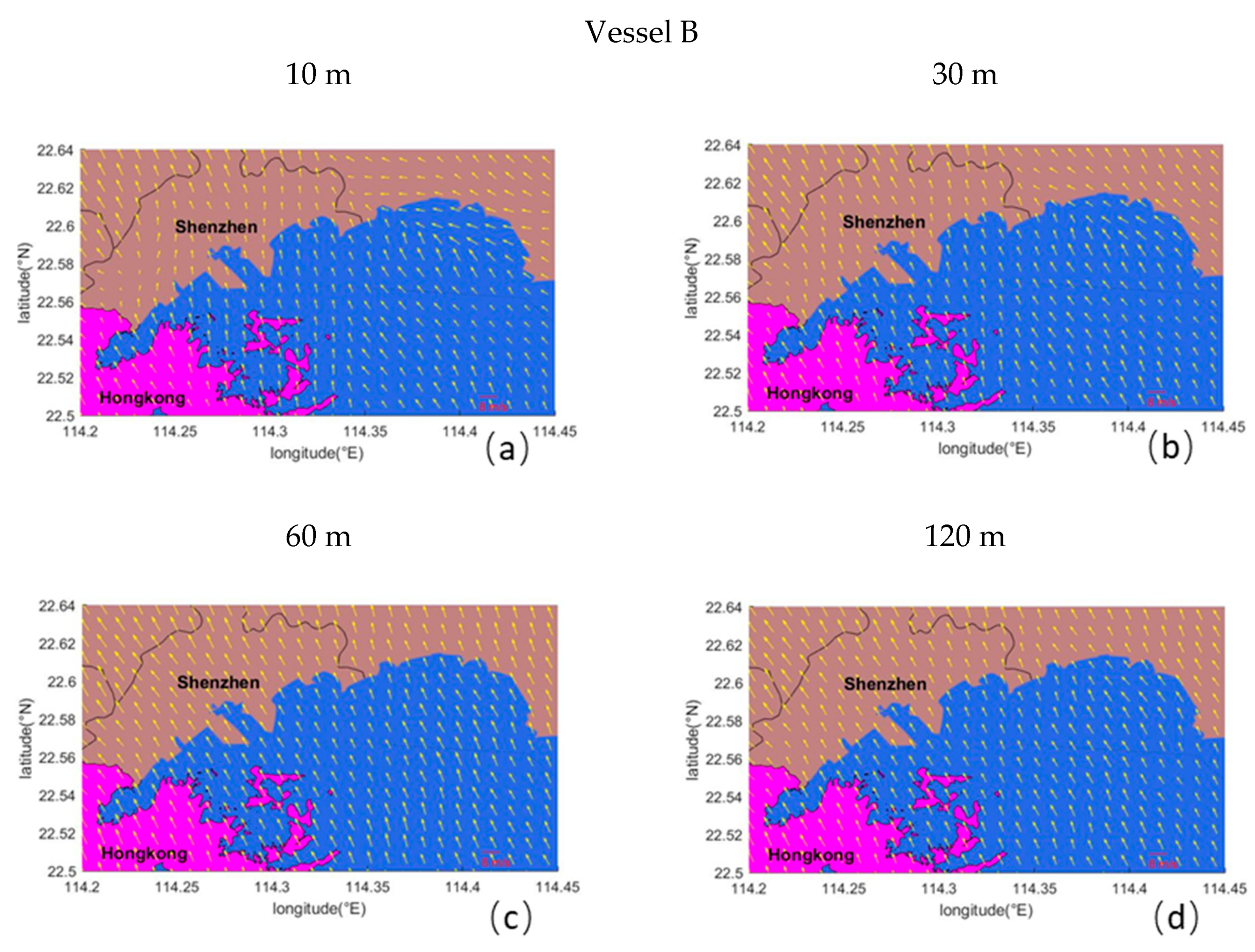
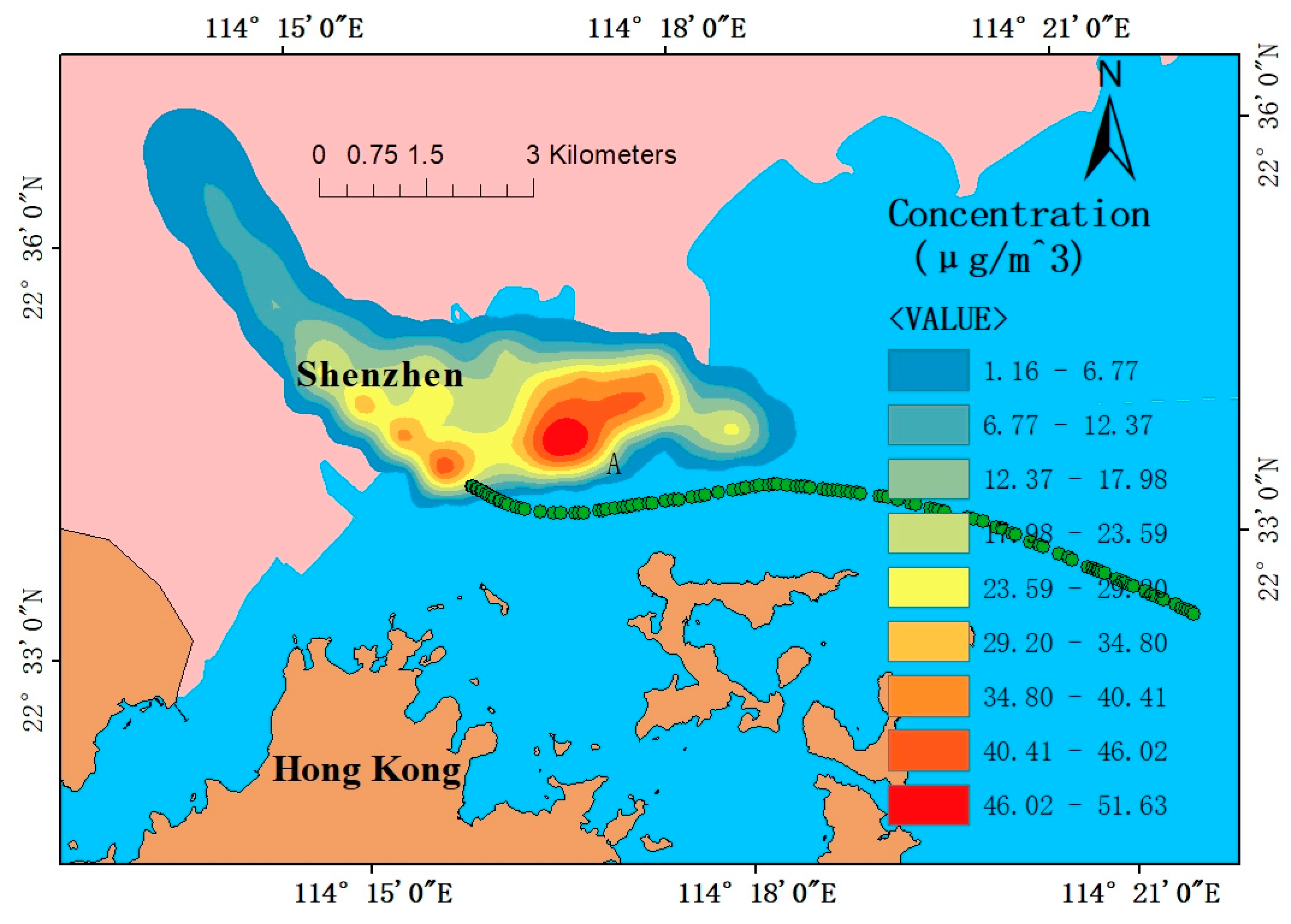
| Physical Parameterization Scheme Setting | |
|---|---|
| Short wave radiation | Dudhia |
| Land surface process | Noah |
| Long wave radiation | RRTM |
| Cumulus convection | Kain–Fritsch |
| Microphysics | Lin |
| Boundary layer | Yonsei University (YSU) |
| Number | Vessel * | Quantity of Funnels | Funnel Height (m) | Average Exhaust Temperature (°C) | Quantity of Main Engine Funnels | Diameter of the Main Engine Funnel (m) | Quantity of Auxiliary Engine Funnels | Diameter of the Auxiliary Engine Funnel (m) |
|---|---|---|---|---|---|---|---|---|
| 1 | G | 7 | 44.05 | 60 | 1 | 3 | 4 | 1.1 |
| 2 | E | 7 | 44.04 | 400 | 1 | 2.866 | 5 | 0.71 |
| 3 | F | 7 | 38.8 | 320 | 1 | 2.1 | 4 | 0.6 |
| 4 | A | 6 | 46 | 350 | 2 | 2.44 | 2 | 1 |
| 5 | B | 2 | 34.69 | 370 | 1 | 3.2 | 1 | 3.2 |
| 6 | C | 8 | 39.04 | 200 | 1 | 1.38 | 4 | 0.98 |
| 7 | D | 7 | 31.7 | 225 | 1 | 1.712 | 4 | 0.508/0.68 |
| 8 | K | 6 | 33.7 | 157 | 1 | 2.2 | 4 | 0.5 |
| 9 | H | 1 | 33.68 | 110 | 1 | 2.6 | - | - |
| 10 | I | 3 | 38.8 | 250 | 1 | 2.3 | 1 | 0.6 |
| 11 | J | 1 | 39 | 47 | 1 | 2.2 | - | - |
| Wind Speed | MB | COR | RMSE | IOA |
|---|---|---|---|---|
| Beizaijiao (BZJ) wind speed | 2.18 | 0.58 | 2.35 | 0.83 |
| Yantiangang (YTG) wind speed | 2.01 | 0.56 | 2.18 | 0.86 |
| Shatoujiao (STJ) wind speed | 2.58 | 0.69 | 2.82 | 0.87 |
| MB | COR | RMSE | IOA | |
|---|---|---|---|---|
| Wind speed | 1.83 | 0.46 | 2.02 | 0.91 |
| Serial Number | Classification | Time | Vessel | Simulation (m/s) | Observation (m/s) |
|---|---|---|---|---|---|
| 1 | Simulation peaks occurrence was ahead of observation peaks | 24 June 2018 0:30–0:50 | A | 4.39 | 2.04 |
| 2 | 24 June 2018 14:30–14:50 | B | 4.10 | 3.89 | |
| 3 | 25 June 2018 0:25–0:55 | C | 5.10 | 4.13 | |
| 4 | 5 July 2018 1:30–2:00 | D | 2.09 | 1.19 | |
| 5 | 25 June 2018 8:05–8:35 | E | 5.67 | 3.62 | |
| 6 | 25 June 2018 21:20–21:40 | F | 1.15 | 1.30 | |
| 7 | 25 June 2018 0:25–0:45 | G | 5.10 | 3.89 | |
| 8 | Simulation peak occurrence was the same as the observation peak | 30 June 2018 14:30–14:59 | H | 2.26 | 2.89 |
| 9 | Simulation peaks occurrence lagged behind observation peaks | 29 June 2018 10:00–10:30 | I | 3.5 | 4.34 |
| 10 | 1 July 2018 8:50–9:20 | J | 2.10 | 3.18 | |
| 11 | 26 June 2018 4:30–4:59 | K | 1.15 | 2.39 |
Publisher’s Note: MDPI stays neutral with regard to jurisdictional claims in published maps and institutional affiliations. |
© 2020 by the authors. Licensee MDPI, Basel, Switzerland. This article is an open access article distributed under the terms and conditions of the Creative Commons Attribution (CC BY) license (http://creativecommons.org/licenses/by/4.0/).
Share and Cite
Bai, S.; Wen, Y.; He, L.; Liu, Y.; Zhang, Y.; Yu, Q.; Ma, W. Single-Vessel Plume Dispersion Simulation: Method and a Case Study Using CALPUFF in the Yantian Port Area, Shenzhen (China). Int. J. Environ. Res. Public Health 2020, 17, 7831. https://doi.org/10.3390/ijerph17217831
Bai S, Wen Y, He L, Liu Y, Zhang Y, Yu Q, Ma W. Single-Vessel Plume Dispersion Simulation: Method and a Case Study Using CALPUFF in the Yantian Port Area, Shenzhen (China). International Journal of Environmental Research and Public Health. 2020; 17(21):7831. https://doi.org/10.3390/ijerph17217831
Chicago/Turabian StyleBai, Shubin, Yuanqiao Wen, Li He, Yiming Liu, Yan Zhang, Qi Yu, and Weichun Ma. 2020. "Single-Vessel Plume Dispersion Simulation: Method and a Case Study Using CALPUFF in the Yantian Port Area, Shenzhen (China)" International Journal of Environmental Research and Public Health 17, no. 21: 7831. https://doi.org/10.3390/ijerph17217831
APA StyleBai, S., Wen, Y., He, L., Liu, Y., Zhang, Y., Yu, Q., & Ma, W. (2020). Single-Vessel Plume Dispersion Simulation: Method and a Case Study Using CALPUFF in the Yantian Port Area, Shenzhen (China). International Journal of Environmental Research and Public Health, 17(21), 7831. https://doi.org/10.3390/ijerph17217831






